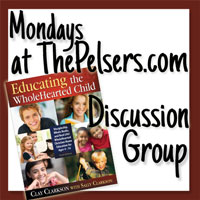This chapter is filled with wonderful ideas for creating an environment for learning in your home.
“… when one entire room or area is permanently dedicated to home education and other dedicated learning places are strategically located throughout the house, it speaks volumes to your children that their learning is so important that you want to give them special places for it.”
“There should be no discernible line dividing lines between home and education.”
pg. 123
So, how do you create a space that invites your children to learn?
We have a modest size home. We have about 1250 sq ft of indoor space which includes 3 bedrooms. When Jacob came along, we made the decision to have the boys share a room leaving the third bedroom to be used as a schoolroom / office area. To this point, our boys prefer to play in the larger family areas rather than in their room. This has left their room dedicated to sleeping and quiet times. It works well for us.
I wrote about our schoolroom a few weeks ago. Go take a look. Simple Ikea tables and magazine file boxes are the foundation of our room. There are plenty of books, crayons, colored pencils, paper, and more accessible to Jonathan.
The Clarksons have lots of suggestions for making use of furniture, table tops, walls and more. Consider creating smaller spaces for focused learning – art, listening, computer, music, and more.
And don't forget the books. Books are very important!
“God created us to be people of his book, the Bible.” pg. 130
One of my favorite tips is to have a wish list of books for Christmas and birthdays. I use an Amazon wish list to collect list of books that we'd like to add to our homeschooling library and our extended family can access this list for gift giving. Most importantly, make sure that you choose good books. The best books, after the Bible, are whole living books. These are books written by one author with a love for their subject. These books move us and cause us to grasp the writer's passion for the subject.
I love the criteria that the Clarksons set out for having books in your home: available, accessible, appropriate, and abundant. In our home even baby Jacob has his books. Jacob has his own basket of easily accessible board books in the living room that he is always pulling books out of. I find him looking at books from that basket a minimum of two times a day if not much more.
The Clarksons suggest not getting caught up in curriculum or scope and sequence lists. These are largely unnecessary. Choosing good whole books and good curriculum that will help teach what you cannot is all you need. Scope and sequence is a formulaic necessity for public school teachers not needed for the homeschooler.
And what about grades?
“There is simply no real need for a record of grades in elementary and middle-school years.” pg. 144
Our state does not require that we keep a record of grades. Our plan is to keep portfolios of work to show progress and teach until something is learned. “Personal excellence” (pg. 144) is the best goal. Expect the best of your children's “A-bility” (pg. 144).
What are the most important things in your learning environment? How do you handle grades?
.png)

